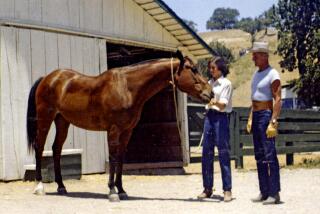BOOK REVIEW / HISTORY : ‘History of Hell’ Is One Heck of a Read : THE HISTORY OF HELL <i> by Alice K. Turner</i> , Harcourt Brace, $29.95, 275 pages
Sixty percent of Americans believe in the existence of hell, a recent Gallup Poll shows, but only 4% are willing to admit that they expect to end up there. If you’re curious about what fate may await the sinner, Alice K. Turner’s “The History of Hell” is a kind of Michelin Guide to the nether regions.
“I myself do not believe in Hell--I could hardly attempt this book if I did,” Turner writes, “but I have found it, literally, an incredibly interesting place to visit.”
“The History of Hell” is a fascinating survey of how “the Great Below” has been depicted in arts and letters over 4,000 years of Western civilization. “This investigation is geographical rather than theological or psychological,” insists Turner, who shows us hundreds of color and black-and-white plates that vividly (and sometimes pruriently) depict what hell is supposed to look like.
But the fact is, Turner’s book reveals a sophisticated mastery of theology and psychology as well as art history and comparative religion. Indeed, the book was inspired by Turner’s graduate studies in comparative literature at New York University. Her musings on the varieties of hell range from ancient Babylon and classical Greece, through Virgil, Augustine, Dante, Milton and Goethe, and all the way to James Joyce, T. S. Eliot and Joseph Heller.
“Far from disappearing in the twentieth century,” she writes, “Hell became one of its most important and pervasive metaphors.”
Turner, the long-serving fiction editor of Playboy, uses “The History of Hell” to flash her intellectual credentials. She ponders the accounts of hell in a dozen dead languages and is capable of expertly and deftly comparing Orpheus, “the Harrower of Hell” in classical Greek mythology, to the Babylonian figure of Gilgamesh, the Egyptian Horus, the Persian Mithra and even Jesus Christ.
And the vision of hell articulated by Origen and embraced by the early church fathers, writes Turner in a showy rhetorical flourish, “is close to Platonic metempsychosis, with a nod to Buddhism.”
Turner glances briefly at pre-Christian notions of hell, but she is mostly concerned with the heyday of hell in Christian art and literature. For example, she is frankly disappointed at the lack of elaboration on what is called Sheol (“The Pit”) in Jewish tradition; her chapter on the Jewish notion of hell flashes by in six spare pages. “Jews,” the author writes, “were either the least morbid or the least imaginative of the Mediterranean peoples.”
By contrast, Turner really seems to enjoy the hellfire-and-brimstone vision of hell that reached its frenzied peak in the art and letters of the medieval era in Europe. “Family values were critical,” she writes with characteristic irony about one early Christian description of hell. “Aborted children blind their mothers with fire; abused children watch their parents mangled by wild beasts.”
Above all, Turner emphasizes that hell was the medieval equivalent of a horror movie, full of frankly erotic images of naked men and women whose ordeal at the hands of the devil was an excuse for a kind of soft-core pornography. “Horrid as the old Hell was,” Turner points out, “it had . . . a certain entertainment value.”
And so does “The History of Hell.” Turner shows us lots of pictures of hell, and the illustrations are really the glory of her book. We are given Hieronymus Bosch and William Blake, of course, but also some surprising images: a 15th-Century illustration shows three beatific youngsters “dining on roast heretic in the Mouth of Hell,” for example, and an architectural detail from an 18th-Century building shows the devil as “a proper Enlightenment demon wearing spectacles.” And Turner points out that a rendering of Purgatory by Bosch “looks uncannily like modern descriptions of ‘near-death experiences.’ ”
For all of their richness and opulence, the color plates in “The History of Hell” are simply too small, and that’s my one big complaint about Turner’s book. I was tantalized by the text, but I had to resort to my big magnifying glass to see what is really going on in Brueghel the Elder’s diableries or Bosch’s “Garden of Earthly Delights.”
More to Read
Sign up for our Book Club newsletter
Get the latest news, events and more from the Los Angeles Times Book Club, and help us get L.A. reading and talking.
You may occasionally receive promotional content from the Los Angeles Times.






